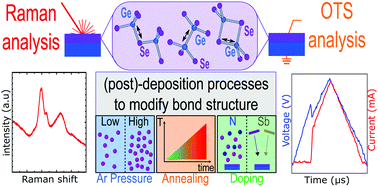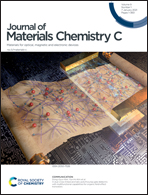Impact of changes in bond structure on ovonic threshold switching behaviour in GeSe2†
Abstract
Raman spectroscopy measurements are performed on sputtered GexSe1−x thin films to identify bond presence. A large amount of homopolar bonds are found, including Ge–Ge bonds that can be attributed to Ge clustering. A time-resolved approach to Raman spectroscopy is explored to observe the effect of the high power-density laser on the sample material. Several methods are then used to tailor the structural bond homogeneity (homopolar–heteropolar bonds): annealing, varying sputter deposition pressure and the addition of dopants. In particular doping can reduce homopolar bond presence and increase heteropolar bonds presence. The impact of each dopant is supported by calculations of bond enthalpies according to Pauling equation using the approach of Lankhorst/Bicerano–Ovshinsky. Finally, in order to correlate the structural bond presence to the Ovonic Threshold Switching behaviour of (doped) GexSe1−x thin films, both DC and pulsed (AC) measurement are performed on metal–insulator–metal (MIM) type test structures. It is found that minimizing homopolar bond presence is beneficial for the leakage current and electrical stability of the material.



 Please wait while we load your content...
Please wait while we load your content...